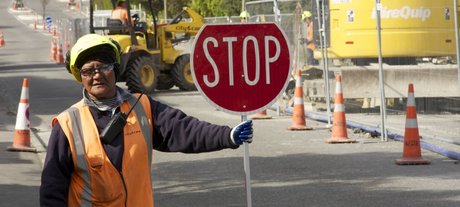Hand signals make way for radio

New Zealand company City Care has swapped voice and hand signals for sturdy Vertex Standard radios.
City Care provides construction, maintenance and management services across New Zealand. Spotters and machine operators work in pairs at worksites. For safety reasons, the spotter watches the hole and digger bucket and is responsible for stopping work if pipes, cables or networks are encountered.
Previously spotters used their voice — difficult in a noisy environment where heavy machinery necessitates earmuffs — or hand signals to communicate. But since May 2015, City Care workers such as spotters and surfacing crews have used Vertex Standard VX456 portable radios.
“The drawback of hand signals is that the spotter can’t always be in a safe place and be seen,” says Brian Keown, landscapes manager at City Care.
“You need good eye-to-eye contact, which can be difficult on some jobs. And obviously the operator can’t signal back if they are operating machinery.”
The radio equipment has changed all that, and the advantages and benefits are many:
Better worker safety: Improved worker safety has been the major purpose and benefit of the rollout. “The addition of the radios is all about improved safety and communication, even across a variety of roles,” says Keown.
Greater efficiency: Departments such as chip sealing and paving have seen greater efficiency. “We were very clear about having a dedicated open channel to provide general communications for excavations,” says Keown. “Efficiency has definitely improved, because everyone can hear what’s going on.
“The trucks now have mounted and mobile sets,” he adds. “So they can enter the site as soon as they arrive because they can hear everything on the open channel as they approach the site. This is more efficient than mobile phones, because very clear instructions are available and drivers aren’t waiting for them.”
Hands-free operation: Clipped to the lapels of workers operating machinery, the radios are light and provide hands-free communication.
Flexibility: “The beauty of our rental fleet is that if someone goes to a spotter job where they can’t see eye-to-eye, they take a set of radios out and bring them back in after the job,” says Keown.
Reliability is also a major factor, of course. “Some radios are used every day, all day, and we have had no battery-life issues,” says Keown.
The system was installed by Vertex Standard partner TL Parker.
“TL Parker have been really good. I like to research and ask lots of questions before committing. They were very patient, helpful, upfront and responsive,” says Keown. “They provided good guidance on what we needed and really understood how we tick. And it’s a good product.”
Canberra celebrates 60-year NASA collaboration with new dish
NASA's Deep Space Network facility in Canberra celebrated its 60th anniversary on 19 March...
ACMA releases views on future use of public airwaves
According to ACMA Deputy Chair Adam Suckling, the agency seeks to ensure the greatest benefit to...
New technique to eliminate signals disrupting radio telescopes
An unexpected television signal traced to an aeroplane has led to a new method for pinpointing...





